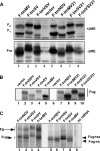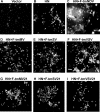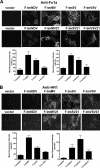The transmembrane domain sequence affects the structure and function of the Newcastle disease virus fusion protein
- PMID: 21270151
- PMCID: PMC3067846
- DOI: 10.1128/JVI.02308-10
The transmembrane domain sequence affects the structure and function of the Newcastle disease virus fusion protein
Abstract
The role of specific sequences in the transmembrane (TM) domain of Newcastle disease virus (NDV) fusion (F) protein in the structure and function of this protein was assessed by replacing this domain with the F protein TM domains from two other paramyxoviruses, Sendai virus (SV) and measles virus (MV), or the TM domain of the unrelated glycoprotein (G) of vesicular stomatitis virus (VSV). Mutant proteins with the SV or MV F protein TM domains were expressed, transported to cell surfaces, and proteolytically cleaved at levels comparable to that of the wild-type protein, while mutant proteins with the VSV G protein TM domain were less efficiently expressed on cell surfaces and proteolytically cleaved. All mutant proteins were defective in all steps of membrane fusion, including hemifusion. In contrast to the wild-type protein, the mutant proteins did not form detectable complexes with the NDV hemagglutinin-neuraminidase (HN) protein. As determined by binding of conformation-sensitive antibodies, the conformations of the ectodomains of the mutant proteins were altered. These results show that the specific sequence of the TM domain of the NDV F protein is important for the conformation of the preactivation form of the ectodomain, the interactions of the protein with HN protein, and fusion activity.
Figures









Similar articles
-
Measles virus fusion machinery activated by sialic acid binding globular domain.J Virol. 2013 Dec;87(24):13619-27. doi: 10.1128/JVI.02256-13. Epub 2013 Oct 9. J Virol. 2013. PMID: 24109225 Free PMC article.
-
Roles of the fusion and hemagglutinin-neuraminidase proteins in replication, tropism, and pathogenicity of avian paramyxoviruses.J Virol. 2011 Sep;85(17):8582-96. doi: 10.1128/JVI.00652-11. Epub 2011 Jun 15. J Virol. 2011. PMID: 21680512 Free PMC article.
-
A mutation in the stalk of the newcastle disease virus hemagglutinin-neuraminidase (HN) protein prevents triggering of the F protein despite allowing efficient HN-F complex formation.J Virol. 2013 Aug;87(15):8813-5. doi: 10.1128/JVI.01066-13. Epub 2013 Jun 5. J Virol. 2013. PMID: 23740987 Free PMC article.
-
Structure and function of a paramyxovirus fusion protein.Biochim Biophys Acta. 2003 Jul 11;1614(1):73-84. doi: 10.1016/s0005-2736(03)00164-0. Biochim Biophys Acta. 2003. PMID: 12873767 Review.
-
Structure and working of viral fusion machinery.Curr Top Membr. 2011;68:49-80. doi: 10.1016/B978-0-12-385891-7.00003-9. Curr Top Membr. 2011. PMID: 21771495 Free PMC article. Review.
Cited by
-
Characterization of complete genome sequence of genotype VI and VII velogenic Newcastle disease virus from Japan.Virus Genes. 2014 Aug;49(1):89-99. doi: 10.1007/s11262-014-1075-7. Epub 2014 May 1. Virus Genes. 2014. PMID: 24788358
-
Virulence during Newcastle Disease Viruses Cross Species Adaptation.Viruses. 2021 Jan 15;13(1):110. doi: 10.3390/v13010110. Viruses. 2021. PMID: 33467506 Free PMC article. Review.
-
Differential Features of Fusion Activation within the Paramyxoviridae.Viruses. 2020 Jan 30;12(2):161. doi: 10.3390/v12020161. Viruses. 2020. PMID: 32019182 Free PMC article. Review.
-
Paramyxovirus fusion and entry: multiple paths to a common end.Viruses. 2012 Apr;4(4):613-36. doi: 10.3390/v4040613. Epub 2012 Apr 19. Viruses. 2012. PMID: 22590688 Free PMC article. Review.
-
The paramyxovirus fusion protein C-terminal region: mutagenesis indicates an indivisible protein unit.J Virol. 2012 Mar;86(5):2600-9. doi: 10.1128/JVI.06546-11. Epub 2011 Dec 14. J Virol. 2012. PMID: 22171273 Free PMC article.
References
-
- Ali, A., and N. P. Nayak. 2000. Assembly of Sendai virus: M protein interacts with F and HN proteins and with the cytoplasmic tail and transmembrane domain of F protein. Virology 276:289-303. - PubMed
Publication types
MeSH terms
Substances
Grants and funding
LinkOut - more resources
Full Text Sources
Other Literature Sources
Research Materials

